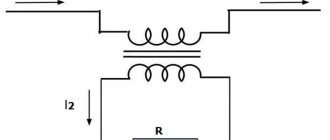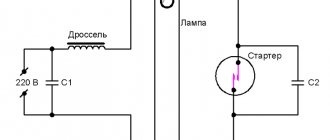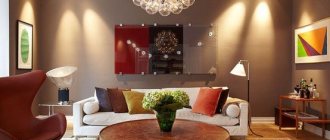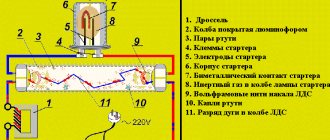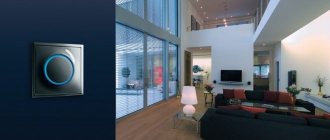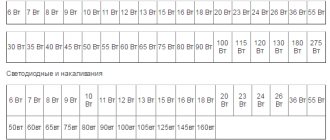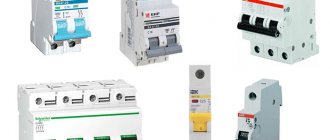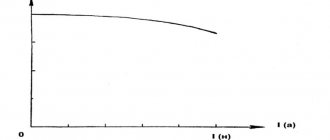Published: 01/28/2012 Category: Electrical Views: 26639
Types of electric lamps
Among all electrical installation and installation products, lighting equipment has the richest assortment. This happens because lighting elements carry not only purely technical characteristics, but also design elements. The possibilities of modern lamps and fixtures, their design diversity are so great that it’s easy to get confused. For example, there is a whole class of lamps designed exclusively for plasterboard ceilings.
Numerous types of lamps have different natures of light and are used under different conditions. To figure out what type of lamp should be in a particular place and what are the conditions for its connection, it is necessary to briefly study the main types of lighting equipment.
All lamps have one common part: the base, with which they are connected to the lighting wires. This applies to those lamps that have a base with a thread for mounting in a socket. The dimensions of the base and cartridge have a strict classification. You need to know that in everyday life, lamps with 3 types of bases are used: small, medium and large. In technical language this means E14, E27 and E40. The base, or cartridge, E14 is often called “minion” (in German from French - “small”).
The most common size is E27. E40 is used for street lighting. Lamps of this marking have a power of 300, 500 and 1000 W. The numbers in the name indicate the diameter of the base in millimeters. In addition to the bases, which are screwed into the cartridge using a thread, there are other types. They are pin type and are called G-sockets. Used in compact fluorescent and halogen lamps to save space. Using 2 or 4 pins, the lamp is attached to the lamp socket. There are many types of G-sockets. The main ones are: G5, G9, 2G10, 2G11, G23 and R7s-7. Fixtures and lamps always contain information about the base. When choosing a lamp, you need to compare these data.
Incandescent lamp with pendant socket and E27 socket
Lamp power is one of the most important characteristics. On the cylinder or base, the manufacturer always indicates the power on which the luminosity of the lamp . It's not the level of light it emits. In lamps of different natures of light, power has completely different meanings.
For example, an energy-saving lamp with a specified power of 5 W will shine no worse than an incandescent lamp of 60 W. The same applies to fluorescent lamps . The luminosity of a lamp is calculated in lumens. As a rule, this is not indicated, so when choosing a lamp you need to rely on the advice of sellers.
Luminous efficiency means that per 1 W of power the lamp produces so many lumens of light. Obviously, an energy-saving compact fluorescent lamp is 4–9 times more economical than incandescent lamps. You can easily calculate that a standard 60 W lamp produces approximately 600 lm, while a compact lamp has the same value at 10-11 W. It will be just as economical in terms of energy consumption.
Base type 2G
Incandescent lamps
“Ilyich’s lamp” is the very first type of electric lamp. The lamp consists of a glass bulb containing a tungsten filament. An electric current passes through the filament, heating it to a temperature that creates light. Such lamps are used, as a rule, in household and decorative lighting, as well as where there are no special requirements for lighting, and the consumption and service life of the lamps are not determining factors.
The advantage of such light bulbs is their low cost. That's probably all. Incandescent lamps cannot provide high quality color rendering, but they can bring an atmosphere of comfort and warmth to your home. They are absolutely not suitable for lighting shop windows and retail spaces in stores where it is important for the buyer to see the exact color of the product.
Incandescent lamps have high energy consumption. There are models of incandescent lamps with different types of coating, which are more economical. When designing the interior, you should take into account the high heat transfer of these lamps and use them at a safe distance from fusible (PVC stretch ceilings, polyurethane decorative elements) and fire hazardous materials.
Table lamp manufacturers
ARTE LAMP
The company from Fanzolo (Venice region, Italy) presents 800 types of lamps to consumers from 20 European countries. A special division of the company develops new lamps that operate on solar batteries and LED technologies.
Brilliant
The Australian lighting manufacturer is working to reduce harmful emissions and produce environmentally friendly equipment.
Brilliant designers listen to customer demands and meet market needs for 3,000 types of lighting equipment.
Camelion
The company produces lighting devices, chargers and batteries. 10 factories are scattered on 5 continents of the globe. Camelion is known as a competent and customer-friendly organization.
EGLO
The company pays attention to reducing the cost of lamps. The company's factories operate in India, China and Hungary. They produce devices in environmentally friendly conditions from environmentally friendly materials.
ERA
The Russian company makes and processes lanterns and lighting equipment. The company's warehouse network covers the entire territory of Russia. The design of the company's products was noted at Russian and international exhibitions.
LUSSOLE
The company produces high-quality elite-class lighting products. The company's lamps are designed by Italian engineers and designers. The LUSSOLE product catalog includes 10 types of devices.
MANTRA
Spanish manufacturer of floor lamps, lighting fixtures are high quality and affordable. The company's designers create products that combine features of classic and high-tech styles.
Maytoni
The German company produces chandeliers, sconces and floor lamps, which are decorated in a classic style. The company's products are supplied to 319 cities in 15 countries. For the manufacture of Maytoni devices, high-quality glass, steel and plastic are used.
MW LIGHT
The lighting manufacturer from Germany makes table lamps and professional lighting equipment. MW LIGHT cooperates with the best lighting equipment designers in Europe.
Odeon Light
The Russian company specializes in the manufacture of devices in office, Tiffany and decorative styles. The catalog consists of 70 models of floor lamps of different colors and shapes.
Halogen lamps
Halogen lamps are an improvement on incandescent lamps. The advantage of halogen lamps is their consistently bright light, excellent color reproduction and the ability to create a variety of light shades.
They are known for moderately high efficiency, light quality, and high wattage ratings compared to conventional incandescent bulbs.
How do they work?
A halogen lamp functions exactly the same as an incandescent lamp, with one notable exception: the halogen cycle. In a conventional incandescent lamp, tungsten slowly evaporates from the burning filament. This causes the lamp to turn black, which reduces light output and shortens lamp life.
Halogen lamps can largely eliminate this problem because the halogen gas chemically reacts with the evaporated tungsten to prevent it from sticking to the glass. The remaining tungsten is returned to the filament, which also increases the life of the lamp. Because the temperature required for this reaction is higher than that of a conventional incandescent lamp, halogen lamps are made using quartz.
Halogen lamps are used in a variety of applications, both commercial and residential. They are used in car headlights, lighting for sofa corners, cabinets, and table lamps.
What is an incandescent light bulb
An ordinary incandescent lamp is a powered light source, the main part of which consists of a refractory material that acts as a filament body. In most cases, such material (conductor) is placed in a vacuum flask or a flask filled with inert gases. When current passes through a conductor, it heats up and begins to emit a bright glow.
Interesting! In order for the tungsten filament of a light bulb to light up, it must be heated to a temperature of about 2000 °C. The incandescent temperature limit can be considered to be 3410 °C.
History of creation
In fact, no scientist has ever invented anything entirely on his own: this is what happened with the “classic” light bulb. Back in 1840, a British inventor named Warren De la Rue designed the first incandescent lamp powered by a platinum conductor. Two years earlier, in 1838, a Belgian scientist named Jobard invented the world's first carbon-core light source. Well, exactly one hundred years before the end of World War II, Heinrich Goebel creates the first prototypes of modern light bulbs.
It is noteworthy that Goebel's first lamp had a charred bamboo thread placed in a vacuum. The scientist continued to work on his brainchild for about 5 more years, after which he presented it to the general public.
Russian scientists also made a significant contribution to the invention, which is now used by the whole world. Thus, in 1874, the first light bulb with a carbon core placed in an airless environment was registered in the name of Alexander Nikolaevich Lodygin. The big problem with such a light source was that carbon as a conductor could not last long enough and burned out soon after use. Over time, the bright minds of the planet came up with the idea of replacing coal with tungsten.
Interesting! When we talk about electricity and lighting devices, we cannot fail to mention the great Thomas Edison. It was he who first created and patented an incandescent lamp that was cheap to produce and durable (relative to most devices of that time).
Since its invention, the familiar light source has not changed much, but technical changes still took place in it: the conductor was replaced with a more advanced one, and the space inside the bulb began to be filled with a special gas.
Design features and principle of operation
Standard LN consists of:
- a flask filled with an inert gas (or devoid of air at all);
- a base that simultaneously serves as both a “lid” of the bulb and an element for connecting the lamp to the network;
- electrodes;
- filament coil located on special supports;
- base contact.
Tungsten was chosen as the conductor material in order to minimize current consumption for heating and reduce the cross-section of the filament to the minimum possible.
Interesting! The resistivity parameter of tungsten is three times greater than that of copper.
The spiral is powered by current from the electrodes, and molybdenum is used as the main material of the “horns” on which the spiral is installed: it is refractory and does not actually expand when heated. The use of an inert gas increases the potential service life of the spiral: in a gas environment it is “more difficult” for it to burn out. As for the base, its size and threads on it may vary.
Characteristics and types
In addition to the usual household drugs we are used to, experts identify several more of their varieties, including:
- Decorative. They are distinguished by non-standard bulb shapes, an enlarged spiral and low lighting. Such devices are most often used by designers to implement projects in the “vintage” style.
- Illumination. They have a bulb painted on the inside and have low power (up to 25 W). They quickly change the shade of the glow, so they require frequent replacement.
- Signal. Previously, they were widely used in various lighting devices, but today in this area they are being actively replaced by LED options.
- Mirrored. The bulb of such a lamp is partially covered with a layer of aluminum that reflects light well, which allows it to concentrate the lighting on a certain point in the space of the room.
- Transport. They are used to equip the optics of cars, tractors, airplanes, various marine vessels, etc. They have increased strength and are resistant to vibration.
- Double strand. A special subtype used in railway traffic lights, airplanes and cars.
Reference. There are other types of LN, but today most of them have been replaced by more modern devices, which will be discussed a little further.
Advantages and disadvantages
The positive qualities of classic LP include low cost, small dimensions, immunity to small voltage drops in the network, a pleasant spectrum of illumination for human vision, a wide range of power options, the absence of toxic or other harmful components in the composition and noise in operation. If we talk about the disadvantages, then among them it is worth mentioning a relatively short service life, a fairly high current consumption and a fire hazard.
Important! The surface around powerful incandescent lamps can heat up to +330 degrees Celsius. Be careful!
Scope of application
Classic LNs are used for household lighting of premises and local areas, commercial real estate, used in automobile, railway and air transport, installed in portable lighting devices (pocket flashlights, etc.), used in cinema, design, medicine and many other sectors of life.
Fluorescent lamps
Fluorescent lamps, also called fluorescent lamps, are divided according to light parameters into lamps with the highest possible luminous flux and into lamps with a lower luminous flux, but increased color rendering quality. Such lamps can emit different colors, which is widely used in lighting offices, store windows and exhibition halls.
Advantages of fluorescent lamps:
- wide color range;
- compared to incandescent lamps, it provides the same luminous flux, but consumes 4-5 times less energy;
- have a low flask temperature;
- increased service life;
Disadvantages of fluorescent lamps
:
- reduces luminous flux at elevated temperatures;
- because they contain mercury, many fluorescent lamps are classified as hazardous waste;
- fluorescent lamps are not suitable for operation at air temperatures below 15-20 °C.
- They may flicker, which negatively affects the work process and your own nerves.
Types of table lamps
Office
Simple and convenient lamps. Suitable for workspaces at home and in the office, children's rooms and bedrooms. Office floor lamps are equipped with mechanisms for adjusting the tilt of individual parts and installing the lamp at different angles.
Such lamps are cheaper than decorative floor lamps.
Tiffany
Tiffany floor lamps are lighting fixtures in which the lampshade is made of colored glass. To make the base of such floor lamps, copper, steel, brass, and wood are used.
Original Tiffany lamps are true works of art that are kept in private collections. Copies of such floor lamps are mass-produced and are available to people with average incomes.
With transparent base
Versatile and stylish interior items. They fit into a setting with warm or cold tones, without harming the overall design. All parts of such floor lamps are made of glass. They are fragile and require careful handling.
Eco
Eco-luminaires are made from environmentally friendly materials:
- wood;
- recycled plastic and paper.
They fit into retro and modern interiors.
Decorative
Decorative lamps are used to decorate rooms. The lampshades of such lamps are made in the shape of spheres, cubes, and polyhedrons. Crystal, plastic, steel, and bronze are used to make the legs. The legs are designed in the form of sculptures or trees.
Fastening
Based on the type of fastening, table lights are divided into 3 types:
- on a clothespin;
- on a clamp (clamp);
- with surface installation.
Devices with fastenings on a clothespin or on a clamp are placed only on the edge of the table, and lamps with fastening to the surface are placed both on the edge and in the middle of the surface.
Depending on the type of switch, table lamps are produced with:
- cord switch;
- touch switch;
- dimmer;
- touch dimmer;
- push-button (on a wire) switch;
- push-button (on the body) switch.
Devices with a touch switch and dimmer are 10-20% more expensive than others, but are not convenient for all users.
Energy saving lamps
Energy-saving lamps produce light according to the same principle as conventional fluorescent lamps, only over a much smaller area. Their design feature is the presence of an electronic unit that ensures ignition and further burning of the lamp. Thanks to it, the energy-saving lamp lights up without flickering and works without blinking, which is typical of conventional fluorescent lamps.
Energy-saving lamps can have different color temperatures, which determine the color of the lamp: warm color, daylight (white) color and cool white color, and accordingly their scope is wider.
- The amount of electricity consumption of these lamps is reduced by 80%;
- The service life is 6-15 times longer compared to conventional incandescent lamps and is, accordingly, 6000-15,000 hours depending on the type;
- Less maintenance losses due to long service life
- Possibility to choose the color of the glow.
The disadvantages include their high cost, but their long service life and low energy consumption compensate for this disadvantage.
The toxic contents of energy-saving lamps require very careful handling. Such lamps cannot simply be thrown into the general trash, they must be handed over to special collection points, and if the lamp breaks at home, then it is necessary to treat the contaminated area in the same way as if you broke a mercury thermometer.
Criteria for choosing a table lamp for the workplace
So, first you need to determine the criteria that you focus on when choosing a table lamp for your desk.
Natural light is the most comfortable and beneficial for the eyes. However, the school period falls on the winter and autumn periods, when it gets dark early, and during daily work or study it is impossible to do without lighting devices. At this time, schoolchildren spend several hours at a desk, so a desk lamp should not cause discomfort or negatively affect vision.
When choosing a table lamp, first of all you should pay attention not to its decorative design, but to the following points, some of which are directly stipulated by the current sanitary standards (SanPiN):
A table lamp is designed to illuminate a certain area of the working surface of a desk.
- The table lamp should give an even and soft glow. Glare and flickering, which negatively affect vision, should be excluded. This causes the eyes to quickly get tired at first, and over time, visual acuity noticeably decreases.
- The light from the table lamp should be supported by overhead lighting.
- There is often a statement that the power of a table lamp should not exceed 100 W, and the optimal parameter is the range of 40–75 W. We will talk about the nuances of this aspect in more detail below, since it is quite controversial.
- It is recommended to purchase a lighting fixture equipped with an adjustable stand, which will allow you to adjust the optimal direction of the light.
- The base of the table lamp should be quite massive and hold the device well on the plane of the table, preventing it from tipping over from any small touch or accidental push.
A properly organized student workplace.
In addition to the characteristics of the desktop device itself, according to the requirements for organizing a workplace for a student, the following factors should be taken into account:
- During the day, the window openings in the room should be open, as access to natural light is necessary.
- The glass on the windows should not have dirt that would prevent natural light from entering the room. Decorating glass with stickers, tinting films, etc. is not allowed.
- Window sills should not be filled with tall indoor plants.
- Light beams cannot be directed from behind or into the child's face.
- When organizing general lighting, you cannot use two types of lamps at the same time - fluorescent and incandescent.
Now that the criteria have been identified, they should be considered in more detail, which will be done in the following sections of the publication.
Types of light sources for table lamps
Several types of lamps can be used for table lighting fixtures - these are conventional incandescent lamps, fluorescent lamps and LED lamps. To decide on their choice, it is necessary to briefly consider their characteristic features.
Prices for table lamps
desk lamp
Tabletop lighting fixture with a universal socket (E27 or E14), suitable for any type of lamp.
- Familiar incandescent light bulbs can have bases of different sizes and different wattages. It is to these light sources that we probably owe the established system for assessing luminescence in watts. Although it should be raised correctly: watts are units of measurement of power consumption, only part of which is converted into glow.
Nowadays, incandescent lamps are inferior to other light sources in almost all respects (except low price).
That’s the problem - the glow of such a lamp is a “secondary product” caused by high-temperature heating of the filament filament, made of a material with very high electrical resistance. That is, the main expenditure of consumed energy is spent on heating (heating). Hence all its shortcomings.
Immediately there is a limitation on the type of lamps used, since even low-power lamp options become powerful sources of heat. The plastic lampshade can not only deform under the influence of high temperatures, but also melt or catch fire. And the metal lamp, if the device works for a long time, gets very hot from the light bulb and, being in close proximity to the child’s face, poses a certain danger of thermal injury (burn). And it’s not particularly pleasant when, say, the room is already stuffy, and the table lamp is also blazing with heat.
In addition to strong heating, incandescent lamps have a number of other serious disadvantages - a very limited service life and significantly high energy consumption, which became especially noticeable with the advent of modern light sources.
Such lamps are not particularly safe - if they fail, the glass bulb can crack, even explode, and the glass can shatter. That is, there is a possibility of a very traumatic situation arising.
The brightness from incandescent lamps is quite high, but it is usually quite far from natural light.
Table lamp equipped with fluorescent light sources.
- Fluorescent energy-saving lamps almost always, after heating, provide an even, calm light, consume less electricity and have a very impressive operational reserve of “survivability”. The advantages of this type of lamps include the fact that they are produced in warm and cold glow, so you can choose an option that is close to natural light.
An important advantage is the fact that the lamp does not heat up to critically high temperatures. That is, the energy consumed is converted to a greater extent into luminous flux, and not into unnecessary heat release.
The disadvantages of energy-saving lamps are the high fragility of the products and the presence of mercury in their bulbs. In addition, such light sources are characterized by flickering, which occurs and intensifies as the lamp consumes its “motor resource”.
Fluorescent lamps are demanding in terms of supply voltage stability. They cannot be used in lighting devices with continuously adjustable glow intensity - with dimmers.
LED table lamp.
- LED lamps are the best option as a table lamp. They almost always have compact sizes with quite sufficient brightness. They can be called the most reliable and safe, since they do not heat up to high temperatures, and even if one of the LEDs burns out, the rest continue to provide light.
The lamps light up immediately, do not blink or flicker, and provide an even, calm light, which is especially valuable for preserving a child’s vision. In addition, LED lamps are the most economical and durable today.
There are table lamps with fixed LED panels or designed to accommodate lamps with a standard socket, and the variety of such LED lamps is extremely wide. That is, even if it fails, there are no problems with replacing it with a new one.
Table lamps with permanent LED panels
It is clear that the disadvantage of table lamps with non-removable panels is that if they burn out, you will have to send them in for repairs or purchase a new lighting fixture.
When choosing a panel version of LED table lamps, you should pay attention to the number of LEDs on the panel - it is recommended that there be at least 12 of them. Although, of course, a lot depends on the power of the elements, the presence of a large number of LEDs will contribute to a more uniform luminous flux.
LED lamps outperform their competitors in almost all respects!
Summarizing this section, we can come to the conclusion that the best option for a table lamp in a children's room would be a lighting device with an LED lamp (panel). Such lamps are by far the safest and most practical, comfortable for the eyes. And in terms of the degree of savings in electricity spent on lighting, they are generally beyond any competition.
Luminous flux of lamps and their color temperature
Now we have come close to this somewhat “slippery” issue of the power of lamps for a table lamp.
As mentioned above, it is believed that the power of a table lamp should not exceed 100 W, but this is also excessively strong lighting for the work area. Practice shows that a 40÷75 W lamp will be sufficient for a tabletop lighting device.
Stop! Here you should correctly understand that we are talking exclusively about incandescent lamps.
We all grew up on such light sources, which is why a very stable stereotype has developed: a certain gradation that compares the consumption of a lamp in watts with the brightness of its glow. But the current norms and rules operate with completely different values. Namely, the illumination of the working area, which is created by the luminous flux emitted by the lamp.
According to the requirements established by SanPiN, the illumination of the working surface of the table should be 300 lux (lux), and if the work involves performing precise drawing work, it can reach up to 500 lux.
Lux, in turn, is the illumination that is created by a point light source with a luminous flux of 1 lm (lumens) over an area of 1 m². It is the characteristic of the luminous flux created by the lamp that should be the main criterion of its “luminous ability”, and not the energy expended in this case.
Determining the required light output of a lamp to achieve the required level of illumination is not an easy task. It takes into account many other factors and requires the use of a special calculation algorithm. If you are interested in this question, there is a detailed explanation on our portal.
How to properly approach providing the required level of illumination?
The task is not easy, requiring a special approach, but still doable. For this purpose, a special calculation algorithm has been developed, which is implemented on the pages of our portal in a set of calculators for calculating room illumination . There you will also find all the tabular data necessary for carrying out the calculations.
So, with equal energy consumption, the light output of different types of lamps can differ several times! But there’s nowhere to go - these same watts of incandescent lamps are simply very firmly entrenched in the subconscious! Therefore, tables of approximate comparison of modern light sources with old incandescent lamps of one or another power consumption are widely used. In addition, manufacturers practice indicating on the packaging of the lamp its actual power consumption and the correspondence of the glow in comparison with a conventional incandescent lamp of one or another power.
Such a table is shown in our article for reference purposes:
| Incandescent lamp, W | Fluorescent, energy-saving lamp, W | LED lamp, W | Luminous flux, lm |
| 20 | 5÷7 | 2÷3 | About 250 |
| 40 | 10÷13 | 4÷5 | About 400 |
| 60 | 15÷16 | 8÷10 | About 700 |
| 75 | 18÷20 | 10÷12 | About 900 |
| 100 | 25÷30 | 12÷15 | About 1200 |
| 150 | 40÷50 | 18÷20 | Around 1800 |
| 200 | 60÷80 | 25÷30 | About 2500 |
Another point that needs to be clarified when choosing a lamp is the shade of light emission. The manufacturer indicates the color of the lamps on the packaging, using a concept such as color temperature.
Color temperature scale for lighting fixtures.
Color temperature is calculated in Kelvin. The essence of this gradation is that as a solid body is heated to high temperatures, it first emits invisible infrared rays. Then a red glow appears - and so on, increasing, through yellow and the most natural white glow - to the blue part of the spectrum.
(Please don’t be scared - this is a relative temperature, and the lamp itself, naturally, does not heat up to such limits).
There is a division into cool, neutral (daytime) and warm white shades. It maximizes productivity and concentration, while preventing eye fatigue from daytime or warm white shades corresponding to 3600÷3800 K. This value can be considered optimal for table lighting.
Prices for wall lamps
Wall lights
The characteristics of the lamps are indicated by the manufacturer on the packaging.
You should not choose a bright, cold white color, as it does not have a very good effect on a person’s condition when the lamp is close to the eyes, causing them to become tired. It is more often used in office premises as overhead general lighting, as well as in sales areas.
Permissible norms of pulsation of a lighting device
When purchasing a table lamp or a light bulb for it, you need to check the lighting fixture for flicker, which has a very negative effect on the retina. To such an extent that vision deterioration may appear over time. In addition, a high pulsation rate adversely affects the nervous system and human psyche, and therefore, those in the zone of such influence unconsciously feel discomfort. He has a desire to quickly leave the area illuminated by the flickering light.
Performing a lamp flicker test using a mobile phone camera
Sometimes it is impossible to distinguish the pulsation with the naked eye, so it is worth using a smartphone for this purpose. Checking the lamp is quite simple - you need to turn on the phone camera and point it at the lamp. The image that appears on the screen usually immediately shows the presence of light pulsation, if any.
Required level of illumination and permissible pulsation coefficients when lighting a desktop.
If the product is of high quality, then the image on the screen will be a stable light spot of any interference. Typically, more expensive models of table lamps (high-quality lamps for lamps) behave this way, which cannot be said about budget options.
It is clear that such a test is quite subjective, and it is impossible to determine the exact parameters using a camera. For such purposes, specialists use special measuring instruments - heart rate monitors and lux meters.
Sanitary standards establish that in living rooms the pulsation of lighting should not exceed 10%, and for incandescent lamps the pulsation coefficient is 12÷14%. The higher the power of the incandescent lamp (150÷200 W), the less it flickers.
The recommended pulsation coefficient of a desk lamp for a student's desk should not exceed 5%. By the way, this is another reason not to install incandescent lamps in desktop lighting devices.
Considering the negative impact of this phenomenon on a person, when choosing a tabletop lighting device, you should pay attention not to the economy and design of the device, but to the safety for the user, especially for the child.
Design features of table lamps
Lamps intended for use on a desk should not have a particularly complex configuration, pretentious, distracting decoration or large dimensions. Their main function is high-quality lighting of the workplace.
If previously the most common models were lamps with a metal shade, under which there was a very hot incandescent light bulb, today you can find various versions of devices with compact sizes on sale. Such models do not take up much space on the table, but provide ideal illumination of the tabletop surface.
Table lamp stand and bases
For a desk, you should choose lamps with an adjustable, flexible or multi-part stand, thanks to which you can accurately position the illuminated area. Another option is that the stand is stationary, but the lampshade with the light bulb is hinged on it, and its position can be changed.
A model of a table lamp on a rigid figured stand, but with a hinged shade.
The best option is probably a flexible stand, since with it you can turn the light in a certain direction with one movement of your hand. Such models are compact and aesthetic, they can be matched to the color of the overall design of the table, then when turned off the lamp will be almost invisible.
Table lamp with adjustable stand, common parallelogram design
A stand consisting of several parts is not so practical and convenient for a child, since it has to be set and secured in the required position. In addition, quite often not very high-quality models of such a design quickly fail. An unsuccessfully placed lampshade can upset the balance, and the lamp may topple, but this is possible if the base of the device is not heavy enough, which often happens in budget versions of products.
Floor lamps that are installed near the workplace or a traditional seating area.
Today you can find varieties of lamps on sale that have high, adjustable stands. They are installed not on the table, but on the floor, next to the workplace. They are convenient in cases where the tabletop is small in size, or a computer monitor, bookshelves, etc. are installed on it, that is, the tabletop version of the lamp cannot be placed as needed.
In addition, the comfort of a floor lamp lies in the fact that the likelihood that a child will accidentally touch it with his hand and turn it over is much lower. But when choosing a similar model of floor lamp, you should also pay attention to the base, which should be massive and stable.
Different lamp mounts to the tabletop.
In addition to the usual installation on a tabletop or next to a table, there are stationary lamp mounts. However, this option is only convenient if the device has a high, adjustable stand.
Stationary models are fixed to the tabletop using a clamp fastening, which covers the thickness of the panel and is screwed from below with a special screw.
In addition to the clamp, there is also a “mobile” mounting option - a clip (clothespin), which can be attached to the edge of the table in any convenient place. Reliability, however, of such structures is not the most outstanding. But if necessary, the table lamp can be moved to another area of the tabletop or hooked onto a bookshelf, where it will be safe from accidental mechanical impact.
Height of the light source above the tabletop
It is also necessary to take into account the height of the light source above the tabletop. It will depend on the parameters of the stand and the possibility of its regulation.
The optimal height is 350 mm, so the recommended rack height should be 400÷500 mm.
The table lamp is most often located on the left side of the table, raised to the optimal height above the tabletop.
A nuance that must be taken into account is the location of the lamp in relation to the computer monitor. It should rise above the screen, and not be located on the side of it, otherwise glare will be formed, which is not harmless to vision. Therefore, when choosing a product, you should not even pay attention to table lamps that have a nice design, but have a low shade.
Adjusting the brightness of the lighting, features of the external design of the table lamp
As mentioned above, the lamp should be moderately bright - the luminous flux should be no more than 400÷700 lm (lumens). But in order to be able to regulate this parameter, manufacturers of many models provide built-in lighting brightness controls - dimmers - in their design.
Prices for table lamps with dimmer
table lamp with dimmer
Table lamp with built-in dimmer.
Thanks to this addition to the lighting device, it will be convenient to work with it both at the computer and while sitting at books or on notebooks. So, when working at the monitor, it is recommended to increase the brightness of the lamp, and for reading or writing abstracts it is slightly reduced.
The brightness control (dimmer) can be mechanical or touch. Each of them has its own advantages.
- A mechanical dimmer involves adjustment using a knob or slider that is moved up or down (left-right, clockwise or counterclockwise) to achieve the desired result. This creates a larger range of light intensity settings.
Touch brightness switch.
- The touch controller, as a rule, has several specific brightness modes, without intermediate lighting intensity options. The transition from one mode to another is carried out by touching directly the sensor or the base of the lamp.
Let us remind you that if you purchased a table lamp with a dimmer, you should not install a fluorescent energy-saving light bulb in it - it is capricious in this regard, and the expected adjustment effect will not be achieved.
If you choose a device with one brightness mode, for example, an LED model with a non-removable panel, then it is better to check the illumination it creates right away in the store. To do this, place a white sheet of A4 paper under the switched on device. If, when light is reflected from it, it is comfortable for the eyes, that is, it does not dazzle, then the brightness can be considered acceptable for using the device on a desk.
It’s easier with lighting fixtures equipped with standard sockets - lamps with optimal luminous flux are simply selected for them
There are several more points regarding the light flux, an excess of which can harm a person’s eyes, no less than its insufficiency.
The illustration shows the correct and unacceptable location of the light bulb in the lampshade.
- In tabletop devices with a standard socket, the lampshade must have a depth in which the bulb bulb will be completely hidden. Or you need to select a compact light bulb of the appropriate size. If the bulb is at least half outside the lampshade, its glow will blind the eyes, which will negatively affect vision.
The coating of the lamp base should not be glossy.
- Another important point is the coating of the base of the table lamp. It should not be glossy or mirrored, since the light hitting it will reflect bright highlights that hit the eyes. This effect can significantly reduce visual acuity. Therefore, the base of the lighting fixture should have a matte finish that does not produce bright reflections.
- It is not recommended to purchase lamps with brightly colored shades for your desk, as this will act as an irritant to the eyes. The best option would be neutral colors - white, black, grey, dark green or dark blue.
Everything said in this subsection may seem like insignificant details to some. However, it is these little things that add up to the unfavorable “risk factors” that affect human health. Especially when it comes to equipping a desktop for a child.
Varieties based on power supply, switches and additional functions
Table lamps can have different types of switches, and each user chooses the one that seems more convenient to him.
Chain switch in a tabletop lighting fixture.
- A chain switch is rarely found on tabletop devices. It is easy to use, since the operating principle of this device is very simple. The lamp is turned on and off by simply pulling the chain. However, this option is more suitable for a table lamp for a bedside table, since more hidden, non-distracting types of switches would be appropriate for a desktop. Often such a cord becomes a “toy” for a child, dissipating concentration when preparing homework. In addition, chains are most often used in budget, short-lived models of table lamps, and such switches themselves often fail.
Key switch.
- The key switch is installed in both budget and expensive versions of tabletop lighting devices. The design is simple, convenient and reliable in operation.
In addition to key switches, some models have push-button versions, but much less frequently than the first ones, since they are still less reliable in operation.
Lamp with a touch switch, with the ability to adjust the brightness and shade of the glow.
- The most convenient way to turn table lamps off and on is the touch option. In this case, you won’t have to pull the chain or even press a button or key. You just need to touch the base body or the device stand. The sensor itself is miniature in size and built into the base of the lamp. Often the on/off sensor also acts as a lamp brightness regulator, and sometimes even allows you to change the shade of light.
Modern table lamps can operate from an electrical network, that is, they are traditionally plugged into a regular outlet. There are models equipped with a built-in battery that needs to be recharged periodically. Such lamps can operate both from the network and completely autonomously.
The illustration shows a table lamp equipped with a rechargeable battery and a USB connector for charging, as well as touch activation and brightness adjustment.
- The convenience of autonomous models is that they can be used when there is no electricity in the house, as well as in places where, for one reason or another, it is not possible to connect to an outlet. However, the battery recharging period is almost equal to the operating time of the device, so when you turn it off, you will have to immediately charge it. For example, the battery takes four hours to charge, and it can work on the accumulated energy for five hours.
By the way, such lamps are convenient in cases where parents want to completely eliminate the possibility of a young child coming into contact with life-threatening voltage.
A device equipped with a power sensor and a digital display.
- In addition to the possibilities listed above, nowadays table lamps for desktops are produced, the control panel with a display is built into the leg. With proper pre-programming, it provides currently relevant information - time and calendar, room temperature and, possibly, humidity; an alarm or timer may be provided. Such models are well suited for older schoolchildren or students, but for children, most likely, the display will, on the contrary, distract from the main lesson and provoke “daring experiments”.
LED bulbs
According to most experts, the future of lighting lies in LED lamps and luminaires. The devices use LEDs as a light source, which emit light when current passes through semiconductor crystals.
- LEDs are 4-7 times more efficient than conventional incandescent or halogen equivalents.
- LEDs have a lifespan of 15,000 to 50,000 hours.
- LEDs illuminate 5-10 times more area than halogen lamps.
- LEDs are more expensive to buy, but cheaper overall when considering lifetime energy use costs.
LED bulbs can be used for landscape lighting, interior lighting, and can be mounted in paving stones, asphalt or a wall. This is an ideal tool for marking and illuminating paths, car parks and places where replacing lamps is quite labor-intensive, for example, in aquariums and swimming pools.
One lamp equipped with a 60-watt incandescent lamp consumes about 525 kWh of electricity per year. Install an LED lamp in this luminaire and annual energy consumption will be reduced to 65 kWh.
Thus, after comparing all the pros and cons of light bulbs, choose the most suitable one for your needs.
Meaning of the word light bulb
Examples of the use of the word light bulb in literature.
To the left of the door is a red emergency light, which began to flash when an alarm was announced, above the door is a blue night light, which turns on after lights out.
In the forced proximity of the plane, under the dim lights, under the insinuating voices of the flight attendants serving drinks, under the tremulous hum that pierces you right through, becoming a part of you and making you believe that you are in a time that is separate from other times, timeless time, a timeless atmosphere of intimacy, Hob and Aurora inevitably entered into a conversation, which became more and more relaxed thanks to the sympathy that flared up between them, unconscious and therefore even stronger.
Having passed through the entryway, Altynnik found himself in a room, hotly heated and lit by a lamp without a lampshade.
I took out from the closet everything in order: counterfeit seals, boxes with multi-colored sealing wax, a heating lamp, amalgam and the entire set of tools for opening packages, consisting of lancets, tweezers, sharpened knuckles, etc.
Al, bending over the steering wheel, looked first at the road, then at the instrument panel, watching the suspiciously shaking ammeter needle, the fuel level indicator and the control light.
The control panels sparkled, as always, the antistatic display shone, the magnetic tapes in the input system were stretched tightly, the green control light was on, the address switch indication was at zero.
Suddenly, a red light flashed on Arlie's control panel, and a shrill squeak drowned out all conversations.
As soon as the connection with the twenty-third floor was lost, Walton turned off the audiovisual intercom unit, leaving without attention a good dozen more who were eager to contact him, as evidenced by the long string of burning lights on the remote control - most of the intercom subscribers had not given up hope of seeing their boss.
About fifteen minutes later, Vasnetsov ran into a small room where a single electric light was burning at full strength and two girls were sitting by the iron stove.
Finally, after several hours of work, they began to get better at assembling and screwing in the light bulbs.
Komarov poked around in the fan hole on the tent dome, stuck a pipe through, screwed something in, twisted it, connected the wire to the electrical wire and turned on the light bulb.
I will still look for approaches, Helen, at every corner I will ask for directions, I will take everything into account - the square with the trams, Nicole, the brooch that you were wearing on the night of the Saint-Martin Canal, Monsieur Ochs's dolls, the ghost of Frau Martha on the Blutgasse, the important and no matter, I will shuffle everything again to find you the way I want - I will shuffle a randomly bought book, a garland of light bulbs, even a block of anthracite that Marrast was looking for in the north of England, a block of anthracite for the statue of Vercingetorix, ordered and half paid for by the municipality of Arkeil13, much to the chagrin of well-meaning townspeople.
The weather, I must say, was favorable: rain, wind, almost demolishing houses, and the area was kind of disgusting, shabby houses, sidewalks in holes, streetlights with broken light bulbs.
You think,” said Vickers, “that those people who make and sell houses also make cars, and lighters, and light bulbs.
The red light on the light display was on, but the call button did not stick.
Source: Maxim Moshkov library
Neon lamp
Neon lamp
You've definitely seen these types, at least in pictures on Instagram. Their maximum is a decorative function, and in recent years the fashion for neon has begun to return. And, of course, this is an integral attribute of New Year’s decorations or lights of a larger city - neon signs, figures, inscriptions and other types of decorations.
Their main feature is the abundance of colors, which depends on the type of gas inside the tube or something else. If you delve a little deeper into physics, everything works from a gas discharge, which produces light of all possible shades. But do not forget that neon lamps can be of a regular color, and, by the way, they are often used. Their main advantage is comparative durability and minimal energy consumption.
Mercury discharge lamp
Mercury gas-discharge lamp
It has several varieties, which are united by one point - the working process. Light bulbs work due to mercury vapor and electrical discharge occurring in the gas. The most well-known option is a mercury arc lamp. It is used to illuminate warehouses, factories, agricultural land and even open spaces. Known for its good light output. All other varieties are based on adding gas to the pressure inside the burner. Therefore, there are several light bulbs that have their own characteristics, but they are not so well known.
Sodium discharge lamp
Sodium gas discharge lamp
Here, the glow is formed after the movement of an electric discharge in sodium vapor, as the name implies. The color itself has a medium shade of mixing yellow with orange, the luminous flux itself is more monochrome. The light spectrum itself is very prominent and has a shimmer to it. Due to this difference, such light bulbs are very readily used for decorative lighting, either architectural or street.
It is almost never used for lighting production sites, but if there are no separate requirements for accurate color rendering, then they are willing to implement it.
There is no absolutely ideal type of light bulb; as you can see, each has advantages and disadvantages, which you should rely on when choosing. Plus, a lot depends on the location of the lighting, and therefore the power, as well as the design of the room itself. Consider all the important details, even with such a small thing as choosing a light bulb. Even if you choose the most expensive light bulb, with a wide range of positive characteristics, and hang it in the wrong place, it will be of little use. Lighting capabilities, as well as your future comfort, directly depend on the right decisions.
Xenon arc lamp
Xenon arc lamp
The process of operation of light bulbs of this type is mainly based on light, which appears due to the movement of an electric discharge in a strictly defined environment. A xenon lamp has two tungsten electrodes, which are placed in a glass bulb. The flask itself contains the gas that is already indicated in the name, xenon. When the voltage reaches the electrodes, an arc is formed between them, which becomes a light source. Due to their good color reproduction, xenon arc lamps work consistently in projectors and stage lighting, as well as in car headlights.
